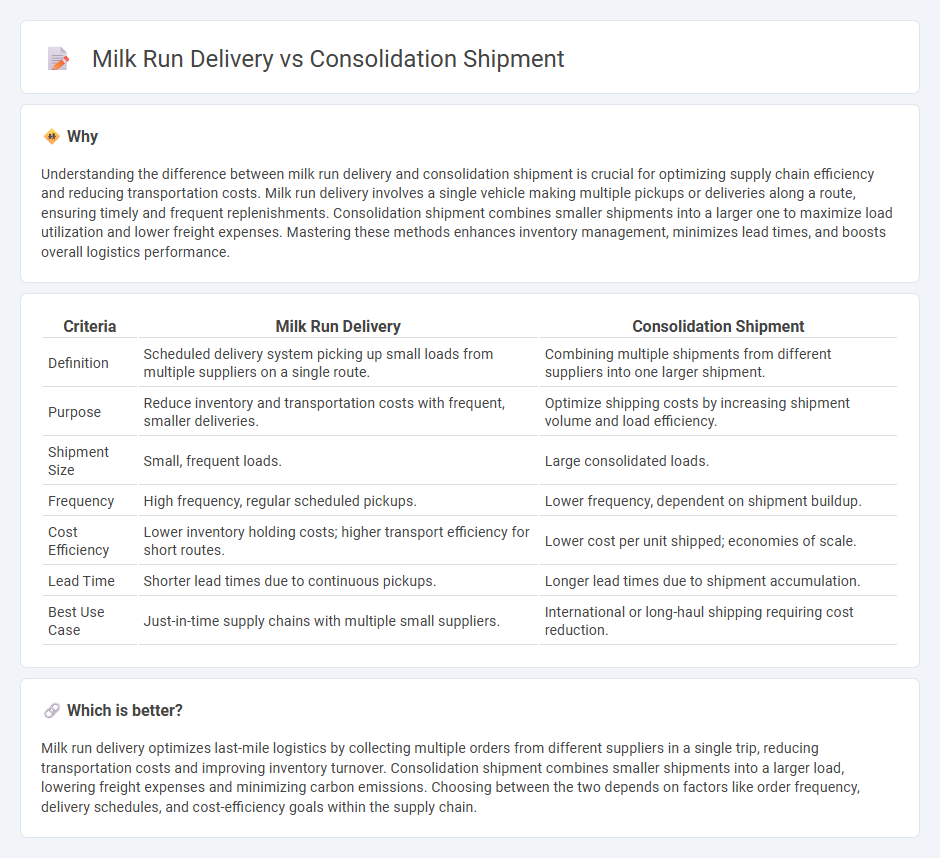
Milk run delivery optimizes logistics by systematically collecting small loads from multiple suppliers in a single trip, reducing transportation costs and improving inventory management. Consolidation shipment combines multiple smaller shipments into one larger load, leveraging economies of scale to decrease freight costs and enhance route efficiency. Discover how choosing between milk run delivery and consolidation shipment can streamline your supply chain operations.
Why it is important
Understanding the difference between milk run delivery and consolidation shipment is crucial for optimizing supply chain efficiency and reducing transportation costs. Milk run delivery involves a single vehicle making multiple pickups or deliveries along a route, ensuring timely and frequent replenishments. Consolidation shipment combines smaller shipments into a larger one to maximize load utilization and lower freight expenses. Mastering these methods enhances inventory management, minimizes lead times, and boosts overall logistics performance.
Comparison Table
| Criteria | Milk Run Delivery | Consolidation Shipment |
|---|---|---|
| Definition | Scheduled delivery system picking up small loads from multiple suppliers on a single route. | Combining multiple shipments from different suppliers into one larger shipment. |
| Purpose | Reduce inventory and transportation costs with frequent, smaller deliveries. | Optimize shipping costs by increasing shipment volume and load efficiency. |
| Shipment Size | Small, frequent loads. | Large consolidated loads. |
| Frequency | High frequency, regular scheduled pickups. | Lower frequency, dependent on shipment buildup. |
| Cost Efficiency | Lower inventory holding costs; higher transport efficiency for short routes. | Lower cost per unit shipped; economies of scale. |
| Lead Time | Shorter lead times due to continuous pickups. | Longer lead times due to shipment accumulation. |
| Best Use Case | Just-in-time supply chains with multiple small suppliers. | International or long-haul shipping requiring cost reduction. |
Which is better?
Milk run delivery optimizes last-mile logistics by collecting multiple orders from different suppliers in a single trip, reducing transportation costs and improving inventory turnover. Consolidation shipment combines smaller shipments into a larger load, lowering freight expenses and minimizing carbon emissions. Choosing between the two depends on factors like order frequency, delivery schedules, and cost-efficiency goals within the supply chain.
Connection
Milk run delivery optimizes logistics by consolidating multiple shipments from various suppliers into a single, scheduled route, reducing transportation costs and improving delivery frequency. Consolidation shipment aggregates smaller loads into full truckloads, enhancing vehicle utilization and minimizing freight expenses. Together, milk run delivery and consolidation shipment streamline supply chain operations by increasing efficiency and reducing overall logistics costs.
Key Terms
Cargo Aggregation
Cargo aggregation in consolidation shipments combines goods from multiple suppliers into one container, maximizing space utilization and reducing shipping costs. Milk run delivery involves scheduled pickups from several locations, ensuring frequent, smaller shipments and minimizing inventory levels. Discover how optimizing cargo aggregation can enhance your supply chain efficiency.
Route Optimization
Consolidation shipment combines multiple smaller shipments into a single load, reducing transportation costs and improving route efficiency by minimizing empty miles and maximizing truck capacity. Milk run delivery involves scheduled, repetitive pick-ups or deliveries along a fixed route, optimizing transportation by ensuring consistent volume and reducing lead times. Explore how advanced route optimization techniques enhance both consolidation and milk run strategies to streamline supply chain logistics.
Cost Efficiency
Consolidation shipment combines multiple smaller orders into one larger shipment, significantly reducing freight costs and maximizing container utilization. Milk run delivery involves a scheduled route collecting goods from multiple suppliers, optimizing transportation and inventory holding costs. Explore how these logistics strategies impact your supply chain cost efficiency for better decision-making.
Source and External Links
Shipment consolidation in logistics: optimizing costs and ... - Shipment consolidation is a logistics strategy that combines multiple smaller shipments from different suppliers at a central hub for optimized loading, transport, and final distribution, utilizing advanced technologies like TMS, IoT, and AI to enhance efficiency while facing challenges such as coordination complexity and regulatory compliance.
What is Consolidated Shipping? Benefits & Challenges of ... - Consolidated shipping merges multiple orders into one shipment to reduce costs but requires robust tracking, coordination among shippers, compliance with regulations, and balancing potential delays and volume needs.
Consolidated Freight Shipping Solutions - UPS Trade Direct - Freight consolidation consolidates shipments into a single load for customs clearance and direct delivery, simplifying logistics, reducing customs time, and speeding delivery through services like UPS Trade Direct that handle transport, customs, and deconsolidation.
 dowidth.com
dowidth.com